Skid plates were once a fairly common way to prolong the life of a skateboard, but now almost solely exist on the underside of freestyle boards. Why do we still use them? Because razortail + pogos = dead board. And considering how quickly freestyle can razortail a skateboard, anything that can protect a kicktail is worth using.
Author: Bob
Review: Mode Freestyle Wheels
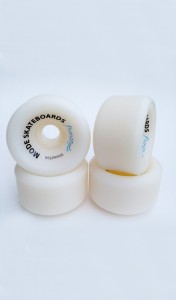
Mode Freestyle Wheels. OK, here we go.
Short version.
I like them. I like both the 99a and the 95a. I like them a lot.
Longer version.
Amazingly, we are now living in the Golden Age of Freestyle wheels.
You, the lucky freestyle skateboarder, now have access to more excellent freestyle wheels than ever before. The 1980s now officially suck. Ten years ago such a statement would have seemed an impossible dream, yet here we are, today, 2016, with more freestyle wheels available than ever before. Don’t believe me? Go to Decomposed’s Wheels Page and see. And that’s not even all of them. It’s missing Sk8Kings. Many of the wheels on that page are deeply offset – a feature usually sought out by freestylers.
Before I get started on the review, and before your are tired of reading, I want to commend and express appreciation to Terry and Jenna Synnott, Dan Gesmer, and Witter Cheng, Richy and Maria Carrasco, and anyone else running smaller companies and creating unique products. We’ll be talking to Terry soon on the podcast, and I want to get into the process and challenges of bringing unique, quality products to market. We in the FS community need to really understand that these are not the massive mega-companies that dominate the skate industry. For Terry, Jenna, Dan, and Witter to actually create products for such a small population of skaters is remarkable and brave. They have invested not only their time, but more importantly their MONEY in these products, and we should be supporting all of them, 100%.
OK, on to the review.
What has been missing from the freestyle scene for several years is an offset wheel less than 97a or 98a hardness. What I personally have missed is having a 95a freestyle wheel. A wheel that’s a little smoother on rough surfaces, a little easier on the ankles and knees upon landing tricks, and a little quieter. In recent memory, Reverse Freestyle has done such a wheel, as has Sk8Kings, but until Mode’s recent release of the 95a version of their freestyle wheel, none have been available for quite a while.
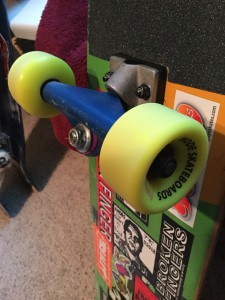
So first, a few words on both versions of the wheels. Here are the stats.
Height: 55mm
Contact patch: 25mm
True width of wheel: 1 3/8″ (35mm)
Bearing seat: Deeply offset
Skaters from the previously mentioned but now not-so-cool 1980s will recognize the shape and overall profile of these wheels as being much like the old OJ Freestyle wheels. This is intentional. The OJs were very popular, and provided the deepest offset of any of the freestyle wheels back then. Terry Synnott, co-owner of Mode, designed these wheels to be very close to these old wheels, but with a 55mm diameter rather than 57mm.
On the rear of the wheels, as you will see if you click on the image to the left and examine the full-sized image, the bearing sits flush with the back face of the wheel. In order to make the wheels handle more quickly and precisely, Mode shaves a lot of material off the wheel, narrowing the contact patch. The result is the width that you need to provide axle-nut coverage on the other side, without creating a lot of drag with a wide contact patch. The outer lip of the wheel is bevelled almost to a round edge, allowing the wheel to break free for shove-its and slides when you want, but still grip impressively when you wish for traction.
At this point, I’ve ridden both the 99a and 95a versions of this wheel, so I want to talk about the differences and strengths of each.
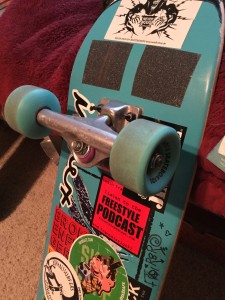
99a. These wheels are extremely fast. The surface I usually practice on is smooth without being slippery. Testing these wheels, they are certainly hard. 99a feels quite a lot harder than the 98a Kevin Harris wheels I’d been using, even though it is only 1 point more. To me, they feel similar in hardness and urethane quality to the 97a Seismic wheels, just a bit harder. The urethane feels really good. As we have mentioned on the podcast, for a hard wheel they grip remarkably well. This no doubt is a result of both high quality urethane and the shape of the wheel. At the 2015 Philly Freestyle, I watch both Mike Osterman and Connor Burke throw 540 Shove-its at will on these wheels, on a fairly slick surface, with total confidence. Good urethane. Good shape.
When I tried these wheels on my own board, what really hit me immediately was the speed these wheels impart. They roll very, very fast. Incredible, really. For 360 spinning, they offer the speed of an even harder speciality spinning wheel, with enough grip to not kill yourself.
95a. I’ll admit that while I was stoked about the original 99a wheels, when Mode announced the development of a 95a wheel I was even more delighted. For my style, I find a smooth, even roll and a little bit more shock absorption is desirable. BUT – you don’t want to go to soft on the durometer, or the wheels would become too bouncy and imprecise, or too mushy so you could feel them deform under your feet as you skate. 95a is really a perfect compromise. Hard enough to get the job done (that’s what she said), but smooth enough to provide a really nice ride (that’s what she said too!).
Getting on these 95a wheels immediately clicked with me. They just felt right. I’ve enjoyed the excellent Seismic Focus 97a wheels, the Decomposed Synnott wheels, and the Skull Skates/Momentum Kevin Harris 98a wheels. All great wheels, and all have their place. These 95a Mode’s are now my go-to wheels for most surfaces. I can see using the 99s in a lot of smooth surface circumstances, since they still have great grip, but these just seem right to my old taste buds.
Right now, Mode is the only wheel company in freestyle to offer a true softer wheel/harder wheel option. I feel like this took guts. Most skaters these days will be very happy to have hard wheels. They are raised on hard wheels. But for a small operation to actually invest in development and creation of a softer freestyle wheel shows passion.
Which one is for you? Depends on your style, where you usually skate, etc. If you are used to hard wheels and like them, I think the 99s will will for you under most conditions. If you want a smoother ride, get the 95s.
— Bob
Episode 22: And Then There Were Four
Podcast: Play in new window | Download
Subscribe: Apple Podcasts | RSS
Simon Mrozinski and Michael Erskine join the podcast crew.
This is an unusually short episode, due to the hour of technical talk about trucks we decided to put into a separate, supplementary episode (22-a), which will be up soon.
We briefly touch on the greatness of Mode wheels, and Bob looks forward to riding the new 95a wheels.
Then we discuss potential dates for the 2016 Paderborn contest, as Bob tries to firm up travel plans.
Next, we discuss issue 5 of Broken Fingers: Freestyle Skateboarding Quarterly. A really great issue. If you are a freestyler, you need to be getting each issue, period. Case closed.
You even get to hear us discuss what the hell we’re gonna do with all the stuff we recorded for this episode!
Music: The intro music is Ty Segal, with the song The Connection Man. Buy it somewhere. The closing music is of course the great David Bowie with Starman. We let it play out. Crank it up and let the ethereal beauty wash over you. Thanks for all the great music, David.
Episode 21: Holiday Season 2015!
Podcast: Play in new window | Download
Subscribe: Apple Podcasts | RSS
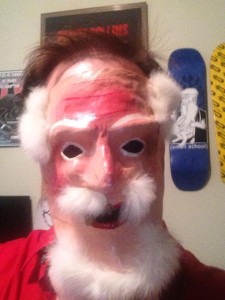 This is our first ever holiday episode. Yes, it is shorter than the last one! yaaaaaay!
This is our first ever holiday episode. Yes, it is shorter than the last one! yaaaaaay!
Links to check out:
Moonshine Skateboards
LateTricks.com
Broken Fingers Freestyle Skateboarding Zine
Episode 20: the Equipment Rant
Podcast: Play in new window | Download
Subscribe: Apple Podcasts | RSS
What happens when we don’t talk for 2 months?
Well, we talked for 3 hours. I cut this down to just under 2 hours. Forgive us, but listen to us! We discuss the Mode Mike Rogers board, flat single kicks in general, the Tyranny of Concave, Mode FS wheels, Kevin Harris FS wheels, Seismic FS wheels redesign, and lots of other stuff.
Yeah, this one is a bit long, but I didn’t feel good cutting out too much. Listen in a couple of sittings if you like, but for episode 20 I thought we’d leave it long.
Review: Mode Mike Rogers Freestyle Deck
I don’t know Mike Rogers. I know a little about him, but I don’t know him. I do know that $5 from the sale of each of these boards goes to Mike’s nonprofit Grind for Life organization.
I do know Terry Synnott, co-owner with his wife Jenna of Mode Skateboards. Terry knows freestyle, and for several years has been producing some of the best FS boards around.
Mike and Terry have gotten together to produce what I would call the first truly modern single-kick flat (non-concave) FS board.
Before I get started with the details, let’s get this out of the way. I love it.
So if my opinion carries any weight with you, that should be enough, and you should also seek mental help, but that’s another issue.
First, the specs:
Length: 28.75”
Width: 7.3”
Nose: 5.5”
Tail: 5.875”
Wheelbase: 13.2”
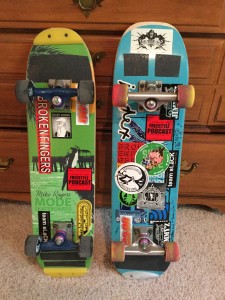
Compared to the freestyle boards of the 80s, this is a fairly big board. The wheelbase is even fairly long by today’s standards, but not overly so. Anyone could have made a board this shape and size. What makes it special is the combination of the shape, size, and mold.
Let me address the issues of concave, flat nose, and rocker, found in this board.
Concave
The board has a very tiny amount of concave at the very outer edges. Having ridden mine for a while now, I can tell you it is really imperceptible. The board essentially has no concave. Why is this good? Thanks for asking. Let me tell you. It’s easier to move your feet around the board when it is flat. There’s no concave to lock your feet into the middle area of the board. I think it makes more of the deck’s surface useable and less likely to tip over if your foot is near the edge. In a skating discipline that is all about moving your feet all over the board, why would you want your feet locked into the middle? Well, you wouldn’t.
Concave was originally incorporated into vert decks to help keep your feet on the board during the weightless part of vert skating. It works really well for that. Generally, it works really well for street skating. As time passed and the modern popsicle shape became popular, concave came to provide several other benefits. It strengthens the board, making it stiffer, and thus allows a thinner, lighter deck. Concave also provides a great advantage for control of ollie tricks (as does a kick-nose). Finally, with concave there is less friction from the bottom of the board during board slides. No grab/slide rails are needed because of this.
For traditional freestyle, none of this really applies.
So with the the Rogers model having only a tiny amount of concave, you lose some stuff that (for someone like me) will not matter at all. You gain more easy-to-use space on the top of the deck.
Flat Nose
A flat nose is perhaps even more anachronistic than a flat, non-concave, deck. Several very good skaters, such as Mike Osterman, Sean Burke, and others, prefer the non-kick nose. Others I know stuck to the flat nose for a long time, but finally gave up on it — just too much trouble to get a flat-nosed board. I was one of those guys. I have been using double kick FS boards for many years now. None of the single kicks in the last 15 years have appealed to me.
On a recent trip to the UK and Germany, I had a chance to ride Simon Mrozinski’s Mike Rogers model. Simon is a footwork master. He has the kind of footwork smoothness and inventiveness I wish I had, and he was really happy with this board. I took a few rides on Simon’s board, and it was clear that I needed to revisit the flat-nose/flat board experience.
The flat nose will not be for everyone. I will say that it is much much better for casper tricks. If you do the casper standing on the nose, you will be on a much more stable area of the board. It’s just a lot easier to get into, hold, and manipulate the casper if you aren’t standing on a curved surface. Some people are able to adjust to the curve of a double kick for this. I can’t. I’m just not that good. I need all the help I can get. The flat nose gives me that help.
I also think the flat nose is better for rail flips, as long as it has a nice tapered, round shape like that of the Rogers. Again, I need all the help I can get. The flat nose just seems to flip and spin easier than a kick nose. I think it is because it is spinning on the same axis as the rest of the board. Now, I can do rail flips on my Mode double kick. But I found them instantly easier and better on the flat nosed Rogers.
I’ve also found fingerflips somewhat easier on the flat nose. I think this is because 1)I grew up using flat nosed boards, and 2)when you flip the board, the nose is flipping on exactly the same axis as the rest of the board. You don’t have to compensate for the slight incline of the nose.
There are just some tricks for which a flat nose works much better.
Drawbacks. There are some. First, you don’t have quite as much clearance for nose wheelies. It is easier to scrape the nose, so you may need to add a riser or adjust your style a bit. I have not found this to be a huge issue, and nose wheelies are one of my main tricks, but it is an issue none-the-less. Footwork feels different. It too requires some adjustment. I’ve also found my 360 shove-its required some adjustment. It is not quite as easy to just feel for the sweet spot for the front foot. Finally, with one end flat, you have to pay attention with the direction of the board for tricks.
Rocker
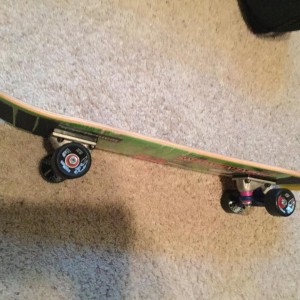
Rocker refers to a downward bend in the middle of the board. A gentle curve, like the runners of a rocking chair. In some old boards the amount of rocker was pretty severe.
The Rogers is pressed from a mold that gives it just a tiny hint of rocker. You can see it in this image. Between the trucks the board bows down just slightly. Why would you want this? My friend Tony Gale has asked his question, and my answer of “It feels good” was not enough for him! So here are a couple of other notions. Terry Synnott thinks that the rocker gives you a hint of the upturned nose advantage, without actually having a kick nose. This is true. It makes sense. It is my experience that by very slightly lowering the board in the middle, it creates a little more stability on the way it feels when you stand on it. Back in the old days it was not uncommon for a board to have bit of rocker. Now you find it mostly in downhill boards. The Rogers mold has just enough to give it a really nice feel.
The Result
When you combine the best aspects of old FS shapes with the size of a modern FS board and a proper mold, you have the makings of a great board. This is why I could call this board the first modern flat-nosed, non-concave deck.
I know that Terry and Mike tried many prototypes of this deck, using different molds. Their work has payed off. I hope that many of you will give this deck a try. Board design is really all about trade-offs. Advantages of bigger vs. small, narrow vs. wide, square nose vs. round nose, etc. It is great that Mode is offering a true range of fully modern FS board designs.